TechRadar Verdict
At $159.99 (about £97.27/AUS $179.56) it's a bit of a niche product, but for the right audience the Sensei Wireless is a great all-around ambidextrous mouse that you'll likely love for the next few years.
Pros
- +
Wired charging pad doubles as a transmitter - a very, very good transmitter
- +
The SteelSeries Engine 3 is educational and offers deep customization
- +
Its battery is tough to run down
Cons
- -
The wireless functionality comes with a premium price tag
- -
No on-board profile storage or bottom LCD
- -
Setting up macro profiles takes a bit of elbow grease
Why you can trust TechRadar
Ten years ago, calling something a "wireless gaming mouse" was an oxymoron. The technology just couldn't support a wireless connection, at least with the precision and speed needed for competitive play.
Well, 10 years and dozens - if not hundreds - of iterations later, the SteelSeries Sensei Wireless mouse is here to show us that wireless convenience and razor-sharp gaming functionality don't necessarily need to be mutually exclusive.
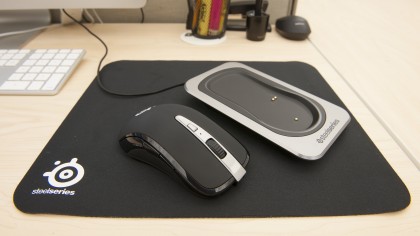
First impressions and wireless mode
Right out of the package, the Sensei is startlingly simple to set up - plug the wired charging pad into an open USB port and you're good to go. The wired charging pad not only serves as a futuristic way to refuel after a long gaming session, but also works as the mouse's wireless receiver.
The biggest reasonable concern about choosing a wireless mouse over a wired option (not that you'll need to choose, but more on that in a second) is input lag. Although the Sensei didn't perform as quite as well using the wireless mode as it did while in wired mode, the results are incredibly close.
Using HumanBenchmark.com I found that the wireless response times were slower, but only by about 20ms. Here were my results:
Wired: Trial 1 275ms, Trial 2 262ms, Trial 3 257ms
Wireless: Trial 1 284ms, Trial 2 283ms, Trial 3 278ms
I ran three trials for each mode, and took the average of five reaction times per trial.
Because this tests human reaction time and not the true mouse's reaction speed there's some slight ambiguity to it, but I feel justified saying the wireless mode isn't quite as fast as when it's wired-in via USB.
Battery life
SteelSeries promised a 20-hour battery life with, I assume, fully glowing display and using the default power saver mode that shuts the mouse down after 15 minutes of inactivity. They over-delivered. It's not rare that this happens, but without the power saving mode I found the battery to be quite difficult to drain. It lasted as long as promised, and even close to low power, it performed without noticeable lag.
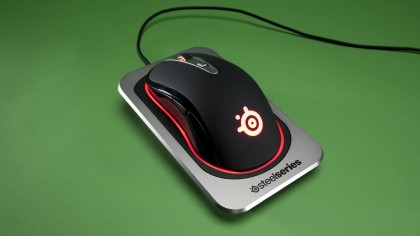
Going from zero charge back to full juice takes a bit of time - 3.5 hours to be exact - but if you're not keen on waiting all you'll need to do is swap the micro USB cable from the charging dock to the interlocking front USB port on your mouse and voila! Now you have a speedy hard-wired mouse while your rechargeable battery gets some much-needed love on the electricity front.
Wired and weight
Stated simply: wired mode feels fantastic. This makes sense considering the Sensei Wireless comes from the company known for the original award-winning wired Sensei.
For those currently using the Sensei proper, know that the Sensei Wireless weighs in at 120g compared to the Sensei proper's much lighter 102g. It's a considerable change, but it's something you can adjust to within a few days of game time.
Also missing was the bottom LCD – still available in the $79 Sensei – that allowed for swapping profiles on the fly. It's sorely missed, however the Sensei Wireless makes up for in other ways (see: rechargeable battery and wireless transmitter).
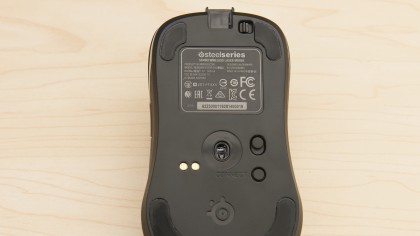
Software
It helps, though, that SteelSeries Engine 3, SteelSeries' customization software, is still as functional as it's ever been. Macro commands are simple to map to one of the four side buttons and can be stored in unlimited profiles that save to the cloud. It's not as convenient as on-board storage - as this requires you to download the software on every computer you use - but cloud storage is a practical, cost-saving solution that's worth setting up. Trust me. Failing to do so caused my unit to form a somewhat…uh, schizophrenic personality.
In it you'll find ways to customize every setting from lift distance to acceleration, from polling rate to macros. You can even toggle handy explanations of what each of these terms mean should you need a refresher – or crash – course in Gaming Mice 101.
My only complaint is that without a fully populated macro library that you would find in, say, Roccat's or Logitech's gaming software, customizing the mouse for your favorite game takes a bit of elbow grease.
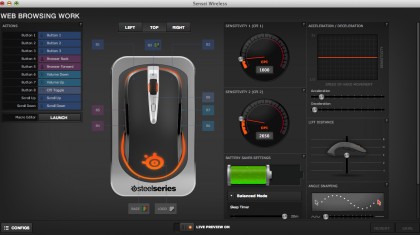
And stringent, must-control-everything gamers may not enjoy that its natural acceleration (an increase in DPI relative to speed of the movement of the mouse) can't be turned off. It can, however, be modified so that you can increase acceleration even further – up to 2x the base 30G – or increase deceleration to effectively make the mouse steadier and require more hand movement to get the pointer to move.
Despite everything I just said, I still managed to set up a web browsing macro profile – featuring back, forward, volume up / down key mappings - within 15 minutes of opening the box.
Form and function
A single DPI switch located south of the scroll wheel achieves what it sets out to do, and though it may not offer as many options for DPI shifting as other mice (I'm looking in your direction Logitech G502…), the two options should suffice for most first-person shooters.
Speaking of the scroll wheel, it also has average scrolling action - and I found it a pleasant mix between smooth and "click-to-click" scrolling. It tracks on the lower side, which may require you to up its correlated option in your system settings, but afterwards you should be set for the life of the mouse.
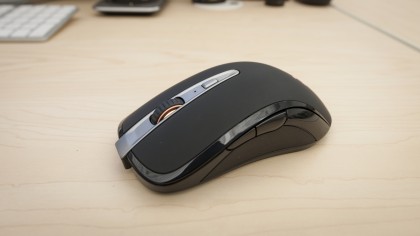
Unfortunately all these features add up to its $159.99 (about £97.27/AUS $179.56) price tag and will likely be more than the average gamer would be willing to spend. This shouldn't be surprising considering the amount of features you get, but regardless, it puts the Sensei Wireless in a slightly higher-paying, niche audience.
Verdict
The Sensei Wireless demonstrates SteelSeries' commitment to quality. Small touches like having the LEDs' color indicate battery level and a locking mechanism that keeps the micro USB in place while in wired mode are appreciated, and functionality both in wired and - more impressively, wireless - is top notch. Its battery life consistently impressed and the accompanying software, the SteelSeries Engine 3, educates while offering a wide array of options. But at $159.99 (about £97.27/AUS $179.56) it's a bit of a niche product and even lost some functionality from its wired, $79.99 predecessor. Still, it's a great all-around ambidextrous mouse that you'll likely come to love for the next few years.
Nick Pino is Managing Editor, TV and AV for TechRadar's sister site, Tom's Guide. Previously, he was the Senior Editor of Home Entertainment at TechRadar, covering TVs, headphones, speakers, video games, VR and streaming devices. He's also written for GamesRadar+, Official Xbox Magazine, PC Gamer and other outlets over the last decade, and he has a degree in computer science he's not using if anyone wants it.

